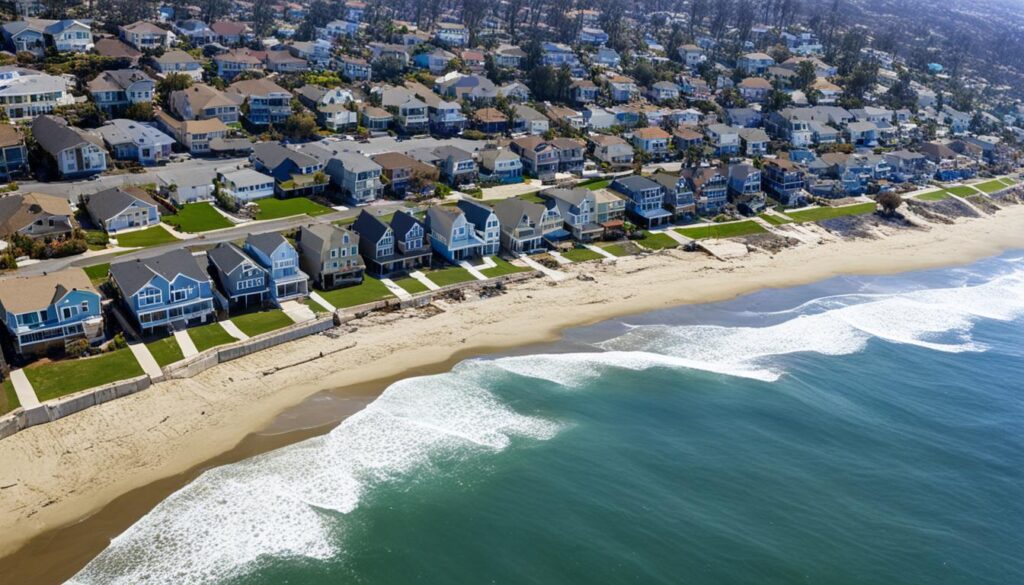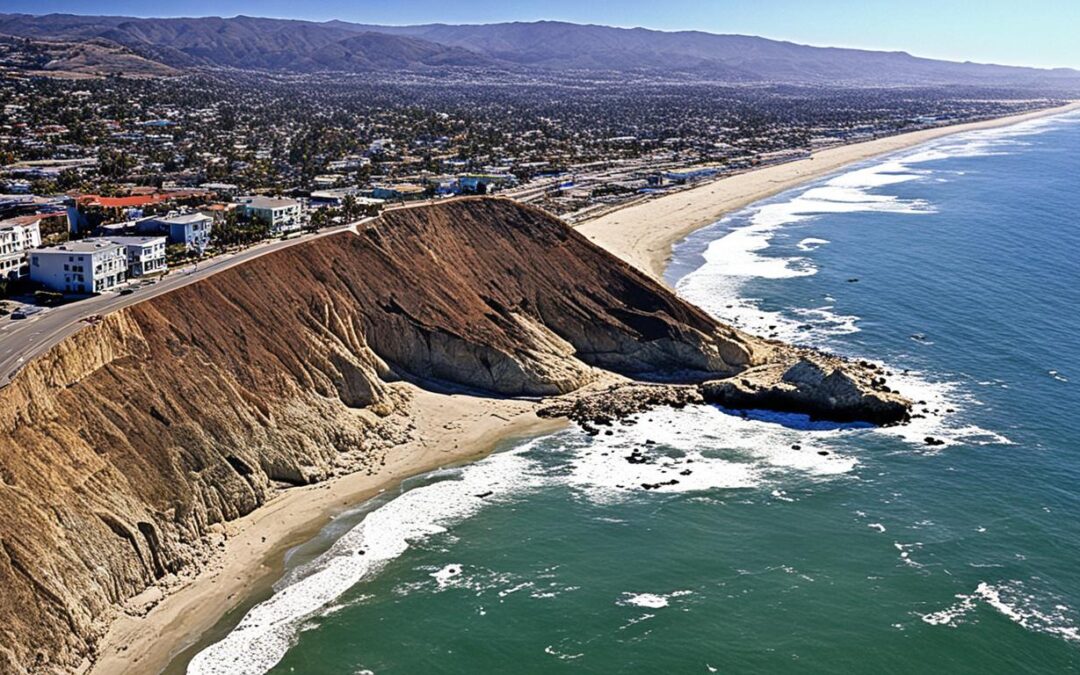Did you know that coastal erosion is posing a significant threat to San Diego’s real estate market? Rising sea levels and climate change are not only putting coastal properties at risk but also impacting property values and posing risks to waterfront properties. This alarming issue has prompted California state Sen. Ben Allen to propose a novel solution to address the problem. Keep reading to discover the potential impacts of coastal erosion on San Diego real estate and how this groundbreaking legislation aims to mitigate these risks.
Key Takeaways:
- Coastal erosion is a growing concern for San Diego real estate due to rising sea levels and climate change.
- The proposed legislation by California state Sen. Ben Allen aims to create a revolving loan program to buy out vulnerable coastal properties and rent them out until they become uninhabitable.
- This solution offers a potential long-term strategy to address the impacts of coastal erosion and declining property values.
- Rising sea levels and climate change put over $100 billion worth of American homes at risk of chronic flooding within the next 30 years.
- Implementing effective coastal erosion mitigation strategies is crucial to protect property values and the environment in San Diego.
The Impact of Coastal Erosion on San Diego Real Estate
The California coast, including San Diego, is highly susceptible to the detrimental effects of coastal erosion caused by rising sea levels and climate change. The rise in sea levels along the California coast over the next century is projected to exceed 9 feet, posing a significant risk to real estate in the region. This presents numerous challenges and implications for property values, investment decisions, and coastal communities.
Existing properties in California, valued at an estimated $8 billion to $10 billion, are anticipated to be underwater within the next 30 years. Additionally, during high tide, an extra $6 billion to $10 billion worth of properties are at risk. These staggering figures highlight the urgency and magnitude of the problem.
Coastal communities in San Diego, like elsewhere, face the challenge of determining the most effective strategies to address coastal erosion while balancing the costs associated with protecting properties. Some options available include defending properties with sea walls and beach buffering, adapting to higher waters, or retreating to higher ground.
Implementing sea walls and beach nourishment as a defense mechanism against erosion comes at a substantial cost and may not provide a long-term solution as sea levels continue to rise. The financial implications of defending properties must be evaluated against the potential loss in property values and tax revenue if coastal erosion persists.
Managed retreat, though contentious, may prove necessary in certain cases to mitigate long-term costs and risks associated with coastal erosion. Relocating properties away from the coast can help safeguard investments and the environment in the face of an uncertain future.
San Diego’s coastline features seasonal variations in oxygen and pH levels, potentially enhancing its resilience against future changes in ocean chemistry resulting from climate change. However, bluff and beach erosion remain significant challenges, demanding immediate attention and the implementation of effective erosion mitigation strategies.

Despite its favorable characteristics, San Diego must address these ongoing erosion challenges and develop robust adaptation strategies to protect property values and the coastal environment. Collaborative efforts between government agencies, local communities, and experts are necessary to implement effective measures such as sea walls, sand deposition, and managed retreat.
Conclusion
Coastal erosion’s impact on San Diego real estate is a pressing issue that requires proactive measures to address the challenges posed by rising sea levels and climate change. As a coastal area, San Diego is vulnerable to the risks of coastal erosion, which can have detrimental effects on property values and the surrounding environment. However, San Diego’s unique characteristics, including its natural variability in sea level, ocean temperature, and chemistry, may provide some advantages in adapting to coastal erosion compared to other coastal areas.
Despite these advantages, bluff and beach erosion remain significant concerns that require attention and mitigation strategies to protect property values and the integrity of the coastal environment. To effectively combat the impacts of coastal erosion, collaboration between government agencies, local communities, and experts is essential. Implementing a range of adaptation strategies, such as the construction of sea walls, sand deposition, and managed retreat, can help mitigate the risks and challenges posed by coastal erosion.
The proposed legislation by California state Sen. Ben Allen, which aims to create a revolving loan program for the purchase and rental of vulnerable coastal properties, offers a potential solution to the problem of coastal erosion. This buy-to-rent strategy could provide a valuable source of income to offset the costs of the loan while making use of high property values in coastal areas before they are affected by erosion and declining property values. By taking proactive steps and implementing adaptation strategies, San Diego can successfully navigate the impacts of coastal erosion, ensuring the resilience and sustainability of its real estate market in the face of rising sea levels and climate change.
FAQ
What is coastal erosion?
Coastal erosion refers to the gradual wearing away of coastal land and features, such as beaches, cliffs, and dunes, due to the action of waves, tides, currents, and storms.
How does coastal erosion impact San Diego real estate?
Coastal erosion can impact San Diego real estate by causing property values to decline and posing risks to waterfront properties. It may also result in the need for costly mitigation strategies to protect properties from further erosion.
What is the proposed state bill by California state Sen. Ben Allen?
California state Sen. Ben Allen has proposed a state bill that aims to create a revolving loan program for California counties and communities to purchase vulnerable coastal properties and rent them out until they are no longer habitable.
Why is the proposed legislation considered a novel approach?
The proposed legislation is considered a novel approach because it has not been tried at such a large scale before. Its implementation would come with questions and challenges.
How much American homes are at risk of chronic flooding within the next 30 years due to rising sea levels?
Rising sea levels and climate change are expected to put over 0 billion worth of American homes at risk of chronic flooding within the next 30 years.
Are coastal communities in California already taking measures to protect their beaches from erosion?
Yes, coastal communities in California, including those in the greater Los Angeles area, are already spending millions to protect their beaches from erosion caused by the rising sea.
What is the potential long-term solution to the problem of coastal erosion?
Buying out vulnerable coastal properties and renting them out is seen as a potential long-term solution to the problem of coastal erosion and its impact on real estate. This strategy aims to utilize the high property values in coastal areas before they are affected by erosion and declining property values.
How can the buy-to-rent strategy help address the challenges posed by coastal erosion in San Diego?
The buy-to-rent strategy could help offset the costs of the loan and provide a source of income to address the challenges posed by coastal erosion in San Diego and other coastal communities.
Why is San Diego considered vulnerable to the impact of coastal erosion?
The California coast, including San Diego, is vulnerable to the impact of coastal erosion due to rising sea levels and climate change. Over the next century, the surge in sea levels along the California coast is expected to be greater than 9 feet, putting a significant amount of real estate at risk.
What are the three options for coastal communities to deal with the threat of coastal erosion?
Coastal communities have three options to deal with the threat of coastal erosion: defending properties with sea walls and beach buffering, adapting to higher waters, or retreating to higher ground.
Why may defending properties with sea walls and beach nourishment not be a long-term solution?
Defending properties with sea walls and beach nourishment is costly and may not be a long-term solution as the sea level continues to rise.
What is managed retreat?
Managed retreat refers to the option of relocating properties away from the coast to avoid the long-term costs and risks associated with coastal erosion. It is a controversial but potentially necessary option in some cases.
How does San Diego’s unique characteristics contribute to its ability to withstand future changes in ocean chemistry?
San Diego’s coastline already experiences seasonal variations in oxygen and pH levels, which may contribute to the region’s ability to withstand future changes in ocean chemistry caused by climate change.
What are the significant challenges that San Diego faces regarding coastal erosion?
Bluff and beach erosion remain significant challenges for San Diego, requiring attention and mitigation strategies to protect property values and the coastal environment.
San Diego can navigate the impacts of coastal erosion and protect its real estate market by developing adaptation strategies, such as sea walls, sand deposition, and managed retreat. Collaboration between government agencies, local communities, and experts is crucial for implementing effective measures.


Recent Comments